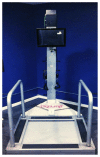Effects of Different Surfaces on Metabolic Cost During Repetitive Jumping: A Pilot Study
- PMID: 37635918
- PMCID: PMC10449323
- DOI: 10.70252/MBDQ5711
Effects of Different Surfaces on Metabolic Cost During Repetitive Jumping: A Pilot Study
Abstract
The purpose of this pilot study was to determine if there is a difference in metabolic cost when jumping on platforms of varying thickness, as well as whether a difference exists in metabolic cost between genders exists on the different platforms. Fourteen participants (seven males and seven females) completed three repetitive jumping trials on the DigiJump machine. Each trial was performed at a cadence of 120 jumps per minute and at a minimum height of 1/2″ per jump. Trials were completed on platforms of 1/2″, 3/8″, and 1/4″ thickness. Participants were instructed to jump as long as possible while maintaining the prescribed cadence or until fifteen minutes had elapsed. There were no differences observed in metabolic cost or exertion for all participants or between genders as indicated by oxygen consumption, respiratory exchange ratio, upper leg RPE, or lower leg RPE. There were also no differences for durations of exercise the participants were able to sustain on the machine. However, when comparing data between genders, a significant interaction was observed in total body RPE across the three platforms (p = .009) and in HR on the 1/2″ platform (p = .018). Results from this study indicate that metabolic cost is similar during repetitive jumping regardless of platform rigidity or gender. However, post-trial comments from participants did show preferences towards specific platforms, though this was not apparent in exercise duration.
Keywords: DigiJump; Platform; VO2; cadence; heart rate.
Figures
Similar articles
-
Evaluation of Metabolic Stress between Jumping at Different Cadences on the Digi-Jump Machine.Int J Exerc Sci. 2010 Oct 15;3(4):233-238. doi: 10.70252/VJMR6012. eCollection 2010. Int J Exerc Sci. 2010. PMID: 27182351 Free PMC article.
-
Evaluation of Repetitive Jumping Intensity on the Digi-Jump Machine.Int J Exerc Sci. 2020 Aug 1;13(2):818-825. doi: 10.70252/WPMP5316. eCollection 2020. Int J Exerc Sci. 2020. PMID: 32922627 Free PMC article.
-
Test-Retest Reliability of the Digijump Machine.Int J Exerc Sci. 2008 Jul 15;1(3):106-112. doi: 10.70252/EIAZ1106. eCollection 2008. Int J Exerc Sci. 2008. PMID: 27182301 Free PMC article.
-
Erratum.Mult Scler. 2016 Oct;22(12):NP9-NP11. doi: 10.1177/1352458515585718. Epub 2015 Jun 3. Mult Scler. 2016. PMID: 26041800
-
Free-leg side elevation of pelvis in single-leg jump is a substantial advantage over double-leg jump for jumping height generation.J Biomech. 2020 May 7;104:109751. doi: 10.1016/j.jbiomech.2020.109751. Epub 2020 Mar 16. J Biomech. 2020. PMID: 32216963
References
-
- American College of Sports Medicine. Guidelines for exercise testing and prescription. 11th edition. Philadelphia, PA: Lippincott, Williams, and Wilkins; 2021.
-
- Borg G. Perceived exertion as an indicator of somatic stress. Scand J Rehabil Med. 1970;(2–3):92–98. - PubMed
-
- Faigenbaum AD, Kang J, Ratamess NA, Farrell A, Golda S, Stranieri A, Coe J, Bush JA. Acute cardiometabolic responses to a novel training rope protocol in children. J Strength Cond Res. 2018;32(5):1197–1206. - PubMed
-
- Getchell B, Cleary P. The calorie costs of rope skipping and running. Phys Sportsmed. 1980;8(2):56–71. - PubMed
LinkOut - more resources
Full Text Sources


